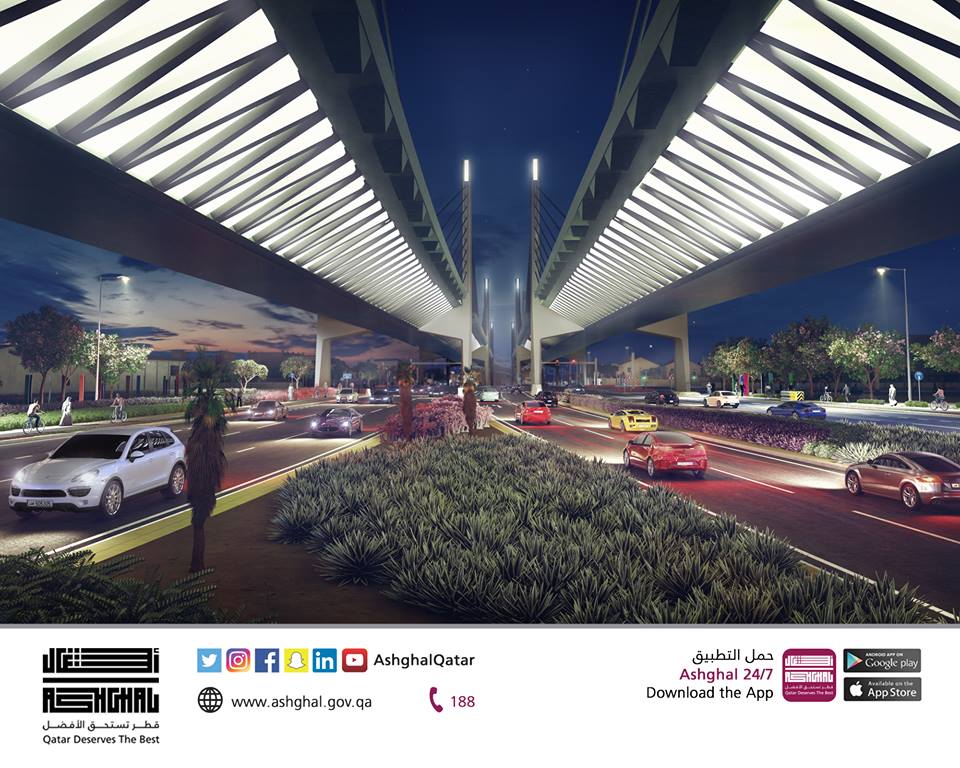The Public Works Authority (Ashghal) has started the construction of the first Cable-Stayed Bridge in Qatar and the conversion of Haloul Roundabout into a two-level interchange on Sabah Al Ahmad Corridor project.
The 1,200-metre long new bridge extends prior to Haloul Roundabout through to the Faleh bin Nasser intersection on Salwa Road to provide free traffic flow between Hamad International Airport and the areas of Abu Hamour, Mesaimeer and Al Waab. The new bridge will consist of four lanes in each direction to accommodate more than 16,000 vehicles per hour.
 Haloul Roundabout will be revamped into a two-level interchange, which will include an at-grade signalised intersection along with the free flow Cable-Stayed Bridge.
Haloul Roundabout will be revamped into a two-level interchange, which will include an at-grade signalised intersection along with the free flow Cable-Stayed Bridge.
After completion, the signalised intersection will consist of six lanes in each direction, including two right turns to the left and one for a U-turn. The intersection will help traffic in all directions connect Sabah Al Ahmad Corridor to Haloul Street and Salwa Road. It will serve Abu Hamour and Al Maamoura, many vital facilities surrounding the Wholesale Market, and commercial activities on Salwa Road.
Due to the length of the bridge, construction work will require the use of 854 precast concrete pieces, each weighing about 200 tons of reinforced concrete, and 20 pylons and 16 piers to reach the highest point of the bridge at 30 metres in height.
Engineer Abdullah Al Naiemi from Ashghal explained that the bridge over Faleh bin Nasser intersection on Salwa Road will be without any pylons at all for a distance of 150 m, but there will be cables to bear the bridge. Completion of the bridge will be in the first quarter of 2021, with the completion of the Halul Intersection works in 2020.
Traffic Diversion on Faleh bin Nasser at-grade Intersection
Stage 1

To facilitate the works, Ashghal announces a partial closure of Faleh bin Nasser Intersection on Salwa Road, while maintaining traffic movement through Sabah Al Ahmad Corridor with the right turns open, starting at 9 pm on 18 April for 48 hours. Commuters heading to and coming from Doha can take the right turn at Faleh bin Nasser Intersection then make a U-turn after around 250 m, then turn right to get back onto Salwa Road. Road users coming from Mesaimeer Road towards Bu Samra, and from Sabah Al Ahmad Corridor towards Doha, will have to continue straight through Faleh bin Nasser Intersection for 250 m, then turn right to get back onto Salwa Road.
Stage 2

There will be a partial closure of Faleh bin Nasser Interchange at-grade for traffic on Salwa Road, starting the morning of Sunday 21 April for 8 months to enable construction work of the bridge on Sabah Al Ahmad Corridor.
During this partial closure, designed in coordination with the General Directorate of Traffic, commuters will be required to use alternative routes.
Sabah Al Ahmad Corridor
Ashghal earlier announced the completion on parts of Sabah Al Ahmad Corridor, such as Al Watiyatt Interchange and Al Rayyan Tunnel, which is the longest and deepest bi-directional tunnel in Qatar.
With the completion of the new Corridor in 2021 the road will have the first Cable-Stayed Bridge in Qatar as well as the largest intersection, longest bridge, deepest and longest bi-directional tunnel.
Sabah Al Ahmad Corridor extends for approximately 25 km from Hamad International Airport to Umm Lekhba Interchange (known as Landmark Interchange) on Doha Expressway. The scope includes the upgrade of seven main roads: E Ring, F Ring, Mesaimeer, Al Bustan, Bu Erayyen, Lebday, and sections of Al Markhiya Street. In addition, Ashghal will enhance 12 km of local and peripheral roads intersecting with the Corridor. The total road works of the project is approximately 37 km.
 Once completed in 2021, Sabah Al Ahmad Corridor will significantly contribute to the relief of traffic congestion on Doha Expressway, in particular 22 February Street. The new Corridor will be a vital alternative and parallel route that will serve thousands of daily commuters from the north to the south of Doha. Commuters travelling from Hamad International Airport will be able to reach Umm Lekhba Intersection in approximately 18 minutes compared to the current 50 minutes via Doha Expressway and 22 February Street, reducing traffic time by 70%.
Once completed in 2021, Sabah Al Ahmad Corridor will significantly contribute to the relief of traffic congestion on Doha Expressway, in particular 22 February Street. The new Corridor will be a vital alternative and parallel route that will serve thousands of daily commuters from the north to the south of Doha. Commuters travelling from Hamad International Airport will be able to reach Umm Lekhba Intersection in approximately 18 minutes compared to the current 50 minutes via Doha Expressway and 22 February Street, reducing traffic time by 70%.
The new Corridor will also form a vital link between the north and the south through Al Doha. This interchange will create a vital connection between Doha Expressway and the Southern Part of Doha Express Highway (Al Wakra Bypass) as well as to Mesaieed Road through Al Watiyyat Interchange at F Ring Road, which will constitute a key point to accommodate traffic to Doha Expressway and Sabah Al Ahmad Corridor.
This significant improvement in traffic will be achieved by increasing the capacity of the road to 20,000 vehicles per hour in both directions, after the current expansion to four and five lanes in each direction rather than three or two lanes in each direction. Meanwhile, the Doha Expressway currently accommodates 12,000 vehicles per hour in both directions.





